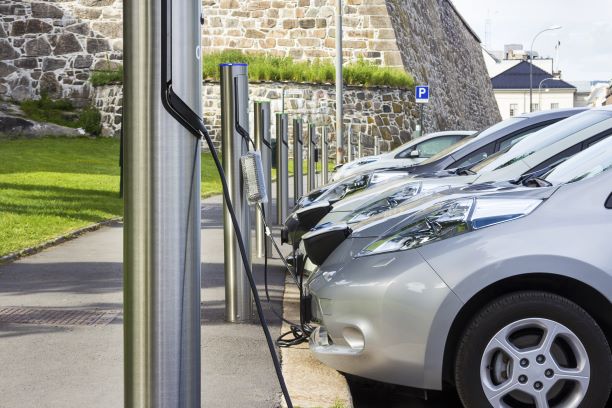
Electric Vehicles

Electric vehicles (EVs) are the future of transportation. An unmistakable sign of this came in July 2020, when Tesla surpassed Toyota as the world’s most valuable carmaker.[1] Certainly in the mind of the investor, electric cars are here to stay. In 2018 and 2019, about 2 percent of new car sales in the US were plug-in vehicles, a threefold increase compared to 2015.[2] This is an important beginning toward meeting climate goals for the transportation sector, which require 90 percent of new US car and light-truck sales to be EVs by 2050.[3]
The promise of EVs depends on decarbonizing the US electricity grid. Electric cars are most prominent on the East and West coasts, where states are heavily invested in growing renewable power, but much less common in many interior parts of the country. There is less climate benefit to EVs in West Virginia or Wyoming, for example, since electricity in those states is still primarily made by burning coal.[4] However, EVs use energy much more efficiently than internal combustion vehicles, so even charging EVs on a heavily fossil fuel–based grid still offers some climate benefit.
Electric Vehicle Technology
Electric cars and light trucks come in three flavors. Hybrid electric vehicles (HEVs) were the first to hit the US market about 20 years ago. They feature an electric battery and drive train in parallel with a gasoline engine. When brakes are applied, some of the energy that goes into stopping the car is redirected to recharge the onboard battery, a process called regenerative braking. From a climate perspective, the continued use of gasoline is problematic, but the high gas mileage of HEVs certainly helps, and these early models helped establish consumer acceptance. Following the HEVs were the plug-in hybrids (PHEVs), which, as the name implies, can also recharge the on-board battery when plugged into the electricity grid. While HEVs rarely operate in battery-only mode, depending on the model PHEVs can travel some dozens of miles before the gasoline engine kicks in.[5]
The future of electric cars is surely in the battery electric vehicles (BEVs), which dispense with gasoline entirely. The number of BEV models has exploded recently, although Tesla still leads the fleet in both luxury and technology. The signature feature is the onboard battery pack, which now permits a driving range comparable to gasoline vehicles in top models—a crucial accomplishment for reaching the mainstream market. BEVs differ according to how the battery can be recharged. Level 1 (110-volt power) and level 2 (240-volt power) chargers can be used at home with any BEV, while level 3 fast chargers are available only at dedicated charging stations. The need for dedicated stations and the length of time it takes (30–60 minutes) to achieve a substantial (60–80 percent) charge still limit BEV growth.[6] A more robust infrastructure with faster charging times will enable more rapid expansion.
Automakers getting into EVs today are mainly competing to produce the best batteries because they are the most important component in the performance of the vehicle. The technical work is challenging because road performance and capacity for fast recharging are both central issues. Consumers demand fast charging times—which generates a great deal of heat—so the battery designs also have to incorporate cooling elements. More power is always desirable, but that achievement involves tradeoffs with battery weight.[7] Integrating the battery with all of the vehicle subsystems that demand power is another crucial element of design.[8] Automakers that best solve these challenges will be the leaders in what is shaping up to be a highly lucrative industry.
The acceleration in EV growth is not coming free of environmental impacts. Today’s EVs mainly employ lithium ion batteries, but lithium mining is driving water scarcity and generating toxic runoff in several places around the world.[9] Lithium is also relatively scarce, which drives an urgent need to develop better recycling methods.[10] Similar concerns surround cobalt, which is incorporated into the positive battery electrode.[11] The potential for much longer battery lifetimes—so-called “million mile” batteries—amplifies these concerns. This breakthrough, likely to increase consumer demand, would lead to less recycling in the short term.[12]
Cars and small trucks dominate energy consumption in transportation (Figure 6), but they are not the whole picture. Electrification of buses is straightforward and is being put in place at large scale in China, which has already converted about a sixth of its bus fleet. But in most US cities, the transition either is barely underway or has not begun at all. Despite the many benefits—much quieter operation, no conventional pollutants, lower operating costs—resistance to the new technology is still strong. And while stop-and-start city bus driving works well with electric motors, the need to put dedicated and costly charging infrastructure in place in crowded urban environments has been challenging. Nonetheless, California has mandated that by 2029 all new buses purchased by its transit agencies must be electric, providing a model for other states.[13] Some cities elsewhere in the country are also imposing electric bus mandates.[14]
Railroads are straightforward to electrify as well. In electric railroads, the power is provided by overhead high-voltage transmission lines that run along the rail routes. Many European and Asian countries have moved in this direction—a seemingly straightforward choice given that electric locomotive engines are both cheaper and easier to maintain than diesel engines. While this is not yet a reality in the US, an advocacy movement has organized to help make it happen (Box 2).[15]
Other parts of the transportation system are more challenging. Only very small aircrafts have been electrified because the power required for commercial airliners is still well beyond the capacity of batteries to supply.[16] This is also the case for shipping, especially the large container ships that dominate energy consumption in this area.[17] In both cases, liquid diesel fuels will be challenging to displace, since their energy density is far in excess of what batteries offer. Finally, heavy trucking is a transportation mode traditionally thought to also require energy-dense liquid fuels. However, in a significant breakthrough, large-truck electrification is coming within reach of battery technology. While long-haul trucking presents a larger challenge, many trucking routes are under 100 miles and well-suited for early electrification efforts.[18] Again leading the way, California’s Air Resources Board has adopted a new rule mandating the elimination of diesel trucks by 2045.[19]
EV battery technology may develop to the point where it can handle all transportation modes, but if not, hydrogen-powered fuel cells could ultimately provide a renewable transportation option that does not depend on batteries. Fuel cells work by combining onboard compressed hydrogen gas with air to generate electricity, which is the same reaction used to burn hydrogen in other energy-requiring applications. A few hydrogen fuel cell electric vehicle (FCEV) prototypes are available today. Like other EVs, these prototypes also carry a battery for auxiliary power.[20]
Although the technology to build hydrogen fuel cells is already available, it relies on expensive catalysts and is not yet cost-competitive. As we’ve discussed, producing renewable hydrogen fuel at large commercial scale still needs many years of development. Once produced, the hydrogen might be transported through the existing natural gas pipeline infrastructure, although this would likely require modification and is still uncertain.[21] Nonetheless, the California LCFS awards credits for renewable hydrogen, both for use in FCEVs and to produce other transportation fuels.[22]
[1] “Tesla Overtakes Toyota to Become World’s Most Valuable Carmaker,” BBC, July 1, 2020, https://www.bbc.com/news/business-53257933
[2] US Department of Energy, Office of Energy Efficiency & Renewable Energy, FOTW#1136, June 1, 2020, Plug-in vehicle sales accounted for about 2% of light-duty vehicle sales in the United States in 2019, https://www.energy.gov/eere/vehicles/articles/fotw-1136-june-1-2020-plug-vehicle-sales-accounted-about-2-all-light-duty
[3] Alexandre Milovanoff, Damiel Posen, and Heather MacLean, “Electrification of Light-Duty Vehicle Fleet Alone Will Not Meet Mitigation Targets. Nature. Climate Change 10 (2020), doi: 10.1038/s41558-020-00921-7.
[4] Kathryne Cleary, Electrification 101, Resources for the Future, December 5, 2019, https://media.rff.org/documents/Electrification_Explainer_101_odobEoP.pdf
[5] “Types of Electric Vehicles,” EVgo, https://www.evgo.com/why-evs/types-of-electric-vehicles/
[6] “Developing Infrastructure to Charge Plug-In Electric Vehicles,” US Department of Energy Office of Energy Efficiency and Renewable Energy, https://afdc.energy.gov/fuels/electricity_infrastructure.html
[7] Ann Steffora Mutschler, “Why EV Battery Design is so Difficult,” Semiconductor Engineering, October 3, 2019, https://semiengineering.com/why-ev-battery-design-is-so-difficult/.
[8] Mutschler, “Why EV Battery Design is so Difficult.”
[9] Amit Katwala, “The Spiralling Environmental Cost of Our Lithium Battery Addiction,” Wired, August 5, 2018, https://www.wired.co.uk/article/lithium-batteries-environment-impact
[10] George Crabtree, “The Coming Electric Vehicle Transformation,” Science 366, no. 6464 (2019): 422-424, doi: 10.1126/science.aax0704
[11] Nicole Kobie, “A Cobalt Crisis Could Put the Brakes on Electric Car Sales,” Wired, February 22, 2020, https://www.wired.com/story/a-cobalt-crisis-could-put-the-brakes-on-electric-car-sales/
[12] Maddie Stone, “‘Million Mile’ Batteries Are Coming. Are They a Revolution?” Grist, July 6, 2020, https://grist.org/energy/million-mile-batteries-are-coming-are-they-really-a-revolution/
[13] Wired, Why electric buses haven’t taken over the world – yet, June 7, 2019, https://www.wired.com/story/electric-buses-havent-taken-over-world/
[14] Julian Spector, “3 Trends Making the Case for Bus Electrification,” Greentech Media:, October 4, 2019, https://www.greentechmedia.com/articles/read/3-trends-making-the-case-for-bus-electrification. For other information on the adoption of EVs by US cities, see Amanda Levin, Seventh Annual Energy Report: Clean Energy Opportunities and Dirty Energy Challenges, National Resources Defense Council, 9, https://www.nrdc.org/media/2019/191106-0.
[15] See https://www.solutionaryrail.org.
[16] Umair Irfan, “Forget Cars. We Need Electric Airplanes,” Vox, April 9, 2019, https://www.vox.com/2019/3/1/18241489/electric-batteries-aircraft-climate-change
[17] Daniel Oberhaus, “Want Electric Ships? Build a Better Battery,” March 19, 2020, https://www.wired.com/story/want-electric-ships-build-a-better-battery/
[18]Ready for Work: Now is the Time for Heavy-Duty Electric Vehicles, Union of Concerned Scientists, 2019, https://www.ucsusa.org/sites/default/files/2019-12/ReadyforWorkFullReport.pdf
[19] “Advanced Clean Trucks.”, California Air Resources Board, https://ww2.arb.ca.gov/our-work/programs/advanced-clean-trucks
[20] “How Do Fuel Cell Electric Vehicles Work Using Hydrogen?” US Department of Energy Office of Energy Efficiency and Renewable Energy,https://afdc.energy.gov/vehicles/how-do-fuel-cell-electric-cars-work
[21] PG&E Gas R&D and Innovation, Pipeline Hydrogen, PG&E, 2018, https://www.pge.com/pge_global/common/pdfs/for-our-business-partners/interconnection-renewables/interconnections-renewables/Whitepaper_PipelineHydrogen.pdf
[22] “LCFS Electricity and Hydrogen Provisions,” California Air Resources Board, https://ww2.arb.ca.gov/resources/documents/lcfs-electricity-and-hydrogen-provisions
